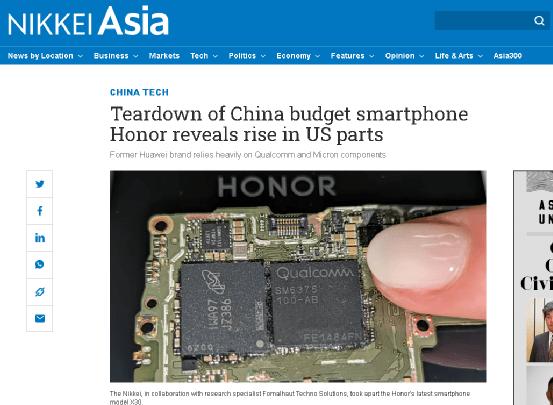According to Nikkei Asia reported on April 25, Nikkei dismantled Honor's latest X30 mobile phone with the help of professional organization Fomalhaut Techno Solutions and found that 40% of the parts used in it were made by American companies.
This shows that the glory of being stripped from Huawei in order to avoid the "coreless availability" dilemma caused by the US ban on Huawei's "entity list" has now quickly returned to the old road of relying on US products.

Nikkei and Fomalhaut Techno Solutions value the X30 internal components to calculate the relative share of components from different countries in X30 production.
The 5G smartphone Honor X30 was launched in December 2021, compared to the Honor 30S released in 2020, which is also owned by Honor, which belongs to Huawei, the share of U.S. parts used by the X30 has soared to 39%, and the Honor 30S is only 10%.
Most of the core components of the X30, including SoC and 5G chipsets, are provided by US manufacturers such as Qualcomm (the part supplied by HiSilicon during the Huawei period).
Nikkei reported that the estimated production cost of the Honor X30 is $217. U.S. parts account for the largest share of costs — 39 percent, nearly four times the 10 percent of the Honor 30S. The share of parts replaced by U.S. parts is mainly domestic parts - as shown in the chart above, the share of domestic parts fell sharply from 37.5% by 27 percentage points to about 10%.
HiSilicon, which originally supplied SoCs, 5G chipsets and power management chips for the Honor 30S, was affected by the sanctions and could no longer supply these parts to honor. On the Honor X30, in addition to the Japanese parts, all the communication chips of the latest models are provided by Qualcomm and another American manufacturer, Qorvo, and the only domestic communication chip components used are communication signal amplifiers, which are said to be based on relatively old technology. (The report also mentioned Micron, but did not elaborate on the situation.)
The report also pointed out that the only relatively expensive domestic part used by the X30 is the display, and the LCD display it uses is estimated at $14, and the current flagship model usually uses an OLED screen that is five times the price.
Japanese parts account for about 16% of the total production cost of the Honor X30, ranking second in share, involving manufacturers including Murata Manufacturing, Sun Power, Sony and so on.
Of course, Honor's heavy dependence on U.S. components, including chips, is not unique to it, and Xiaomi and OPPO are also dependent on key components from U.S. suppliers. Fomalhaut data shows that Xiaomi's folding model launched in 2021 has a 26% share of U.S. parts for the Xiaomi MIX Fold, and OPPO's Reno 6Pro+ has 31%.
Under the restrictions of the "entity list" in the United States, Honor has worked with its parent company Huawei to significantly shrink its shipment volume and market share due to the inability to purchase a large number of parts and components. Since the divestiture from Huawei in November 2020, Honor has restored its procurement capabilities for related parts, gradually restored the market competitiveness of its products, and returned to the forefront of its shipment rankings.
According to IDC data, Honor ranked fifth in the Chinese smartphone market in 2021 with a share of 11.7%, and it even climbed to the second place in the fourth quarter of 2021 (October to December) after Apple.
Honor has returned to the old road of relying on American parts, and at the same time, it has strongly and large-scale recovered the reality of the previous Huawei + Glory brand market share, which deserves our attention.
As far as the supply chain field of non-complete machines is concerned, it is true that domestic manufacturers have made significant progress in the field of science and technology over the years, but the current reality is still that "old powers" such as the United States and Japan occupy a dominant position. Domestic manufacturers still need to redouble their efforts!